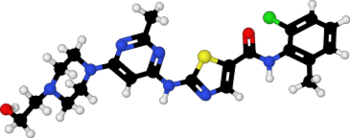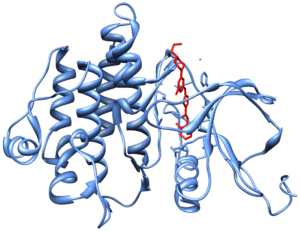Dasatinib
Dasatinib, sold under the brand name Sprycel, is a targeted therapy used to treat certain cases of chronic myelogenous leukemia (CML) and acute lymphoblastic leukemia (ALL).[1] Specifically it is used to treat cases that are Philadelphia chromosome-positive (Ph+).[1] It is taken by mouth.[1]
 | |
 | |
| Clinical data | |
|---|---|
| Trade names | Sprycel, Dasanix |
| AHFS/Drugs.com | Monograph |
| MedlinePlus | a607063 |
| License data | |
| Pregnancy category | |
| Routes of administration | By mouth (tablets) |
| ATC code | |
| Legal status | |
| Legal status |
|
| Pharmacokinetic data | |
| Protein binding | 96% |
| Metabolism | Liver |
| Elimination half-life | 1.3 to 5 hours |
| Excretion | Fecal (85%), kidney (4%) |
| Identifiers | |
IUPAC name
| |
| CAS Number | |
| PubChem CID | |
| IUPHAR/BPS | |
| DrugBank | |
| ChemSpider | |
| UNII | |
| KEGG | |
| ChEBI | |
| ChEMBL | |
| CompTox Dashboard (EPA) | |
| ECHA InfoCard | 100.228.321 |
| Chemical and physical data | |
| Formula | C22H26ClN7O2S |
| Molar mass | 488.01 g/mol g·mol−1 |
| 3D model (JSmol) | |
SMILES
| |
InChI
| |
| | |
Common side effects include low white blood cells, low blood platelets, anemia, swelling, rash, and diarrhea.[1] Severe side effects may include bleeding, pulmonary edema, heart failure, and prolonged QT syndrome.[1] Use during pregnancy may result in harm to the baby.[1] It is a tyrosine-kinase inhibitor and works by blocking a number of tyrosine kinases such as Bcr-Abl and the Src kinase family.[1]
Dasatinib was approved for medical use in the United States in 2006.[1] It is on the World Health Organization's List of Essential Medicines, the most effective and safe medicines needed in a health system.[2] In the United Kingdom, as of 2015, the medication costs the NHS about 2,505.00 pounds per month of treatment.[3] An Indian company has said they could make a generic version for US$4 per dose.[4]
Medical uses
Dasatinib is used to treat people with chronic myeloid leukemia and people with acute lymphoblastic leukemia who are positive for the Philadelphia chromosome.[5]
Adverse effects
Neutropenia and myelosuppression were common toxic effects. Fifteen people (of 84, i.e. 18%) in the above-mentioned study developed pleural effusions, which was a suspected side effect of dasatinib. Some of these people required thoracentesis or pleurodesis to treat the effusions. Other adverse events included mild to moderate diarrhea, peripheral edema, and headache. A small number of people developed abnormal liver function tests which returned to normal without dose adjustments. Mild hypocalcemia was also noted, but did not appear to cause any significant problems. Several cases of pulmonary arterial hypertension (PAH) were found in people treated with dasatinib.[6]
On October 11, 2011 the U.S. Food and Drug Administration (FDA) announced that dasatinib may increase the risk of a rare but serious condition in which there is abnormally high blood pressure in the arteries of the lungs (pulmonary hypertension, PAH). Symptoms of PAH may include shortness of breath, fatigue, and swelling of the body (such as the ankles and legs). In reported cases, people developed PAH after starting dasatinib, including after more than one year of treatment.
Information about this risk has been added to the Warnings and Precautions section of the Sprycel drug label.[7]
Pharmacology

The main targets of dasatinib are BCR/Abl (the "Philadelphia chromosome"), Src, c-Kit, ephrin receptors, and several other tyrosine kinases.
History
Dasatinib was developed by collaboration of Bristol-Myers Squibb and Otsuka Pharmaceutical Co., Ltd,[9] and named for Bristol-Myers Squibb research fellow Jagabandhu Das, whose program leader says that the drug would not have come into existence had he not challenged some of the medicinal chemists' underlying assumptions at a time when progress in the development of the molecule had stalled.[10]
Cost
The Union for Affordable Cancer Treatment objected to the price of dasatinib, in a letter to the U.S. trade representative. The average wholesale price in the U.S. is $367 per day, twice the price in other high income countries. The price in India, where the average annual per capita income is $1,570, and where most people pay out of pocket, is Rs6627 ($108) a day. Indian manufacturers offered to supply generic versions for $4 a day, but, under pressure from the U.S., the Indian Department of Industrial Policy and Promotion refused to issue a compulsory license.[4]
Bristol-Myers Squibb justified the high prices of cancer drugs with the high R&D costs, but the Union of Affordable Cancer Treatment said that most of the R&D costs came from the U.S. government, including National Institutes of Health funded research and clinical trials, and a 50% tax credit. In England and Wales, the National Institute for Health and Care Excellence recommended against dasatinib because of the high cost-benefit ratio.[4]
The Union for Affordable Cancer Treatment said that "the dasatinib dispute illustrates the shortcomings of US trade policy and its impact on cancer patients"[4]
Brand names
In Bangladesh dasatinib is available under the trade name Dasanix by Beacon Pharmaceuticals.
References
- "Dasatinib". The American Society of Health-System Pharmacists. Retrieved 8 December 2017.
- "WHO Model List of Essential Medicines (20th List)" (PDF). World Health Organization. March 2017. Retrieved 29 June 2017.
- British national formulary : BNF 69 (69 ed.). British Medical Association. 2015. p. 614. ISBN 9780857111562.
- Cohen, D (4 November 2014). "US trade rep is pressing Indian government to forbid production of generic cancer drug, consortium says". BMJ (Clinical Research Ed.). 349: g6593. doi:10.1136/bmj.g6593. PMID 25370846.
- Keating, GM (January 2017). "Dasatinib: A Review in Chronic Myeloid Leukaemia and Ph+ Acute Lymphoblastic Leukaemia". Drugs. 77 (1): 85–96. doi:10.1007/s40265-016-0677-x. PMID 28032244.
- "NHS - Healthcare News". nelm.nhs.uk. Archived from the original on 2013-05-05. Retrieved 2011-09-27.
- FDA: Sprycel (dasatinib): Drug Safety Communication - Risk of Pulmonary Arterial Hypertension, 10/11/2011.
- Tokarski, J. S.; Newitt, J. A.; Chang, C. Y.; Cheng, J. D.; Wittekind, M.; Kiefer, S. E.; Kish, K.; Lee, F. Y.; Borzillerri, R.; Lombardo, L. J.; Xie, D.; Zhang, Y.; Klei, H. E. (2006). "The Structure of Dasatinib (BMS-354825) Bound to Activated ABL Kinase Domain Elucidates Its Inhibitory Activity against Imatinib-Resistant ABL Mutants". Cancer Research. 66 (11): 5790–5797. doi:10.1158/0008-5472.CAN-05-4187. PMID 16740718.
- https://www.otsuka.co.jp/en/company/release/2015/0302_01.html, http://news.bms.com/press-release/rd-news/fda-approves-us-product-labeling-update-sprycel-dasatinib-include-three-year-f, http://news.bms.com/press-release/financial-news/bristol-myers-squibb-announces-extension-us-agreement-abilify-and-estab
- Drahl, Carmen (16 January 2012). "How Jagabandhu Das made dasatinib possible". The Safety Zone blog. Chemical & Engineering News. Retrieved 29 August 2016.
External links
- Summary Basis for Approval from the U.S. Food and Drug Administration Freedom of Information Homepage
- Sprycel Summary of Product Characteristics (from the European Medicines Agency Website) Link dead 12/1/19
- Discovery of N-(2-Chloro-6-methyl-phenyl)-2-(6-(4-(2-hydroxyethyl)-piperazin-1-yl)-2-methylpyrimidin-4-ylamino)thiazole-5-carboxamide (BMS-354825), a Dual Src/Abl Kinase Inhibitor with Potent Antitumor Activity in Preclinical Assays